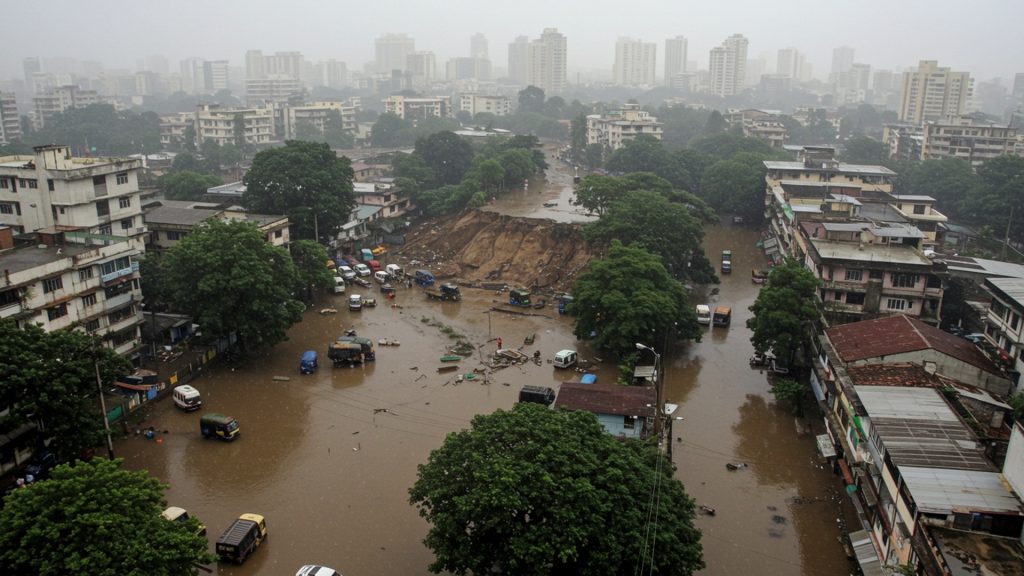Mumbai is drowning under relentless heavy rains today, bringing the bustling city to a standstill as widespread flooding and sudden landslides wreak havoc. The downpour, continuous since early morning, has turned roads into rivers, making daily commutes impossible for millions and trapping residents in their homes. Emergency teams are working to rescue those affected by the mudslides, especially in low-lying areas, where houses are submerged and power is out. This severe weather event not only paralyzes transport networks but also poses a grave risk to life and property, forcing authorities to issue urgent warnings as the city grapples with the deluge.
City Faces Intense Downpour and Waterlogging
Mumbai has experienced heavy rainfall over the past few days, leading to widespread waterlogging and significant disruptions across the city. The India Meteorological Department (IMD) issued a red alert for Mumbai and Raigad on August 16, warning of very heavy rainfall. An orange alert was also issued for Thane for August 16-17. On August 17, the IMD downgraded Mumbai’s red alert to an orange alert but warned that heavy to very heavy rainfall is expected in some places. The weather conditions are expected to remain similar for at least the next three days, with an orange alert continuing for Mumbai, Thane, Palghar. Raigad. Raigad has a red alert for August 18 and Palghar for August 19.
The city recorded significant rainfall in various areas. Between 8:30 AM on August 15 and 8:30 AM on August 16, Vikhroli received the highest rainfall at 257. 5 mm, followed by Santacruz with 244. 7 mm. Sion with 228. 0 mm. Juhu recorded 219. 5 mm, while Bandra and Byculla received 184. 0 mm and 172. 0 mm, respectively. In the eastern part of the city, Chembur logged 131. 5 mm of rain. Colaba recorded 83. 2 mm.
Many low-lying areas in Mumbai experienced severe waterlogging. These include Gandhi Market, Kings Circle, Andheri Subway, Kurla, Chembur, Milan Subway, SCLR Bridge. Sion Railway Station. Navi Mumbai areas like Vashi also saw severe inundation, with people wading through knee-deep water.
Landslides Lead to Fatalities
Amid the heavy rains, Mumbai has faced deadly landslides. A landslide in Vikhroli (West) on August 16, 2025, killed two people and injured two others. The incident occurred around 2:39 AM at Varsha Nagar in Vikhroli Parksite. Soil and stones from a nearby hillock collapsed onto a hut, affecting four members of one family.
The victims were identified as Shalu Mishra (19) and Suresh Mishra (50), who were declared dead at Rajawadi Hospital. Aarti Mishra (45) and Ruturaj Mishra (20) sustained injuries and are in stable condition under treatment.
Emergency response teams, including fire brigade personnel, local police. civic staff, were immediately sent to the site. Other residents in the affected area have been moved to safer locations.
Vikhroli has been identified as a landslide-prone area. Between 11 PM on August 15 and 5 AM on August 16, Tagore Nagar in Vikhroli recorded 213 mm of rain. Vikhroli West saw 211 mm.
Transport Network Disrupted
The heavy rainfall has severely affected Mumbai’s transport network, especially the local train services, which are considered the city’s lifeline.
- Local Trains: Services on both Central and Harbour Lines have experienced major delays due to waterlogging on tracks. Commuters reported delays of up to 40 to 45 minutes on the Harbour Line, with up-line services towards Chhatrapati Shivaji Maharaj Terminus (CSMT) being most affected after Vadala Road station. Waterlogging between Vikhroli and Kurla caused delays of 15 to 20 minutes on the Central Line. Tracks near Sion and Bandra stations were also inundated.
- Road Traffic: Waterlogged streets led to traffic slowdowns and diversions. Areas like Sion, Kings Circle, Gandhi Market. parts of Navi Mumbai were heavily affected. The tunnel from Mankhurd T Junction to Maharashtra Nagar was closed. the Aarey underpass on Marol Maroshi Road was impassable.
- Air Travel: Private airlines like SpiceJet and IndiGo issued advisories about possible delays in arrivals and departures at Chhatrapati Shivaji Maharaj International Airport.
Government Response and Relief Measures
The Brihanmumbai Municipal Corporation (BMC) and other disaster management agencies have been working to manage the situation.
Mumbai Police issued an advisory: “Mumbai is experiencing heavy rainfall. Water-logging and reduced visibility have been reported in several areas. Mumbaikars are advised to avoid non-essential travel and to exercise caution while venturing out. Police have been instructed to be on high alert and @MumbaiPolice is alert and ready to help Mumbaikars. In case of any emergency, dial 100/112/103.”
BMC officials stated that pumping operations were underway in many areas. response teams were deployed to handle complaints of waterlogging and fallen trees. Municipal Commissioner Bhushan Gagrani visited the disaster management control room to give instructions to officials.
The Disaster Risk Management Master Plan, updated in 2010, focuses on flood control, infrastructure projects. advanced warning systems to protect the city’s population from such events.
Impact on Daily Life
The heavy rains have significantly impacted the daily life of Mumbai residents. Schools and offices faced disruptions, with many people finding it difficult to commute.
Visibility dropped to 9 km in some areas, making driving conditions dangerous. High humidity indoors also led to discomfort. Residents were advised to stay indoors, carry waterproof gear. plan for traffic delays.
Despite the challenges, Janmashtami celebrations proceeded, though BMC kept pumping stations and disaster management teams on high alert.
Monsoon Patterns and Outlook
Mumbai’s climate is tropical, characterized by distinct wet and dry seasons. The city receives a large amount of rainfall during the Southwest Monsoon, typically from June to September. The average annual rainfall in Colaba is 2,213. 4 mm and in Santacruz is 2,502. 3 mm.
The monsoon arrived in Mumbai on May 26, 2025, which was 16 days earlier than its normal onset date of June 11. This marks the earliest monsoon arrival over Mumbai between 2001 and 2025.
The IMD forecast predicts that heavy rainfall activity over Maharashtra is very likely to continue until August 21, 2025. Moderate to heavy rain is expected in Mumbai city and suburbs for the next 48 hours, with a possibility of very heavy rainfall and gusty winds.
Temperatures are expected to range around 27°C (80°F) for maximum and 24°C (75°F) for minimum.
The heavy downpour is expected to replenish Mumbai’s lakes and reservoirs, which will help boost water reserves for the coming months. Tulsi Lake has already started overflowing.

